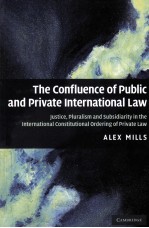
- 作 者:
- 出 版 社:CAMBRIDGE UNIVERSITY PRESS
- 出版年份:2009
- ISBN:0521731305
- 标注页数:395 页
- PDF页数:418 页
请阅读订购服务说明与试读!
订购服务说明
1、本站所有的书默认都是PDF格式,该格式图书只能阅读和打印,不能再次编辑。
2、除分上下册或者多册的情况下,一般PDF页数一定要大于标注页数才建议下单购买。【本资源418 ≥395页】
图书下载及付费说明
1、所有的电子图书为PDF格式,支持电脑、手机、平板等各类电子设备阅读;可以任意拷贝文件到不同的阅读设备里进行阅读。
2、电子图书在提交订单后一般半小时内处理完成,最晚48小时内处理完成。(非工作日购买会延迟)
3、所有的电子图书都是原书直接扫描方式制作而成。
1Justice, pluralism and the international perspective 1
1.1 Introduction 1
1.2 Justice, pluralism and private international law 3
1.2.1. Justice and the application of foreign law 4
1.2.2. Justice and jurisdiction 6
1.2.3. Justice and foreign judgments 8
1.2.4. Party expectations 8
1.2.5. Conclusions 10
1.3 Perspectives on private international law 10
1.3.1. The systemic perspective 10
1.3.2. National and international perspectives 12
1.3.3. Autonomy and mutuality 14
1.4 Justice revisited 16
1.4.1. Conflicts justice 16
1.4.2. Systemic justice 17
1.4.3. Private international law rules as secondary rules 19
1.5 The components of private international law 20
1.6 The international character of private international law 23
1.7 Outline 24
2 The private history of international law 26
2.1 Introduction 26
2.2 The origins of private international law 28
2.2.1. Roman law 29
2.2.2. The statutists 30
2.2.3. The common law 36
2.3 The positivist ‘revolution’ in international law 37
2.3.1. General features of positivism 37
2.3.2. Sovereignty and state practice 38
2.3.3. The positivist account of international law 40
2.3.4. Positivist international law and private international law 44
2.4 Natural law 53
2.4.1. Natural law and international law 53
2.4.2. Natural law and private international law 56
2.5 Historicism 61
2.5.1. Historicism and international law 61
2.5.2. Historicism and private international law 63
2.6 The end of the private history of international law? 66
2.6.1. The decline of universality 66
2.6.2. Self-limitation in public and private international law 70
2.6.3. Private international law as national law 71
2.7 Conclusions 72
3 From positivism to constitutionalism 74
3.1 Introduction 74
3.2 Critiques of positivism 75
3.2.1. The myth of sovereignty 75
3.2.2. Explanatory critique 78
3.2.3. Normative critique 79
3.3 Beyond positivism 81
3.3.1. New natural law 81
3.3.2. New historicism 84
3.3.3. Sovereignty reconsidered 87
3.4 Challenges to the international/national legal divide 88
3.4.1. Explanatory critique 89
3.4.2. Normative critique 96
3.5 International constitutional law and subsidiarity 99
3.5.1. Constitutionalism and international ‘secondary norms’ 100
3.5.2. Universalism and the supremacy of international law 102
3.5.3. Subsidiarity 103
3.5.4. The allocation of regulatory authority 106
3.5.5. International federalism and global governance 107
3.6 Conclusions 112
4 Private international law and constitutional law in federal systems 115
4.1 Introduction 115
4.2 ‘Federal’ private international law 117
4.2.1. The possibility of federal private international law 117
4.2.2. Internal and international private international law 117
4.2.3. The slow development of federal private international law 119
4.2.4. The special role of private international law in federal systems 122
4.3 The United States 125
4.3.1. Private international law - international or constitutional? 127
4.3.2. The two revolutions in United States private international law 133
4.3.3. The impact of the constitution on State choice of law rules 140
4.3.4. The impact of the constitution on exceptions to State choice of law rules 145
4.3.5. The impact of the constitution on jurisdiction 147
4.3.6. The impact of the constitution on the recognition and enforcement of judgments 151
4.3.7. Explaining the weak impact of the constitution on US private international law - subsidiarity and regulato competition 152
4.4 Australia 157
4.4.1. Applicable law in diversi jurisdiction 157
4.4.2. Early interpretation of the Full Faith and Credit clause 159
4.4.3. The Australian revolution - choice of law in tort 162
4.5 Canada 167
4.5.1. The Canadian revolution - jurisdiction and the recognition and enforcement of judgments 168
4.5.2. The Canadian revolution - choice of law in tort 173
4.6 The European Union 175
4.6.1. The need for European private international law 177
4.6.2. Private international law and the internal market 180
4.6.3. The expanding role of private international law 182
4.6.4. Subsidiarity and the idea of private international law as structure 185
4.6.5. Private international law as a system of rights protection 187
4.6.6. Reconciling structure and rights protection 198
4.6.7. Mutual recognition and the ‘country of origin’ principle 200
4.7 Conclusions 205
4.7.1. Private international law as structure 206
4.7.2. Private international law as rights protection 207
4.7.3. Federalism and private international law 209
5 The confluence of public and private international law 211
5.1 Introduction 211
5.2 Evidence of a systemic perspective in private international law 213
5.2.1. International law and institutions 214
5.2.2. The United States 217
5.2.3. Common law states and the European Union 222
5.2.4. Conclusions 224
5.3 Constitutional structure 224
5.3.1. International regulation of regulation 225
5.3.2. Territoriality 234
5.3.3. Personality 246
5.3.4. Cultural identity and private international law 255
5.3.5. Public policy 257
5.3.6. Interests and connections 259
5.4 International rights protection 264
5.4.1. The development of international private rights 264
5.4.2. The domestic effect of international rights 269
5.4.3. International rights in the formulation of private international law rules 271
5.4.4. International rights in the application of private international law rules - international public policy 274
5.4.5. International harmonisation of procedural law 287
5.5 International economic law and private international law 288
5.6 Party autonomy 291
5.7 Subsidiarity in private international law 295
6 Conclusions 298
Bibliography 310
Index 388
